
An alphabet is a standard set of letters written to represent particular sounds in a spoken language. Specifically, letters largely correspond to phonemes as the smallest sound segments that can distinguish one word from another in a given language. Not all writing systems represent language in this way: a syllabary assigns symbols to spoken syllables, while logographies assign symbols to words, morphemes, or other semantic units.
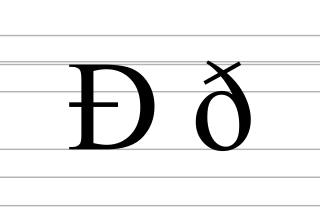
Eth, known as ðæt in Old English, is a letter used in Old English, Middle English, Icelandic, Faroese, and Elfdalian.

G, or g, is the seventh letter of the Latin alphabet, used in the modern English alphabet, the alphabets of other western European languages, and others worldwide. Its name in English is gee, plural gees.

The Latin alphabet, also known as the Roman alphabet, is the collection of letters originally used by the ancient Romans to write the Latin language. Largely unaltered with the exception of a couple splits, additions, and extensions, it forms the Latin script that is used to write most languages of modern Europe, Africa, America and Oceania. Its basic modern repertoire is standardised as the ISO basic Latin alphabet.

R, or r, is the eighteenth letter of the Latin alphabet, used in the modern English alphabet, the alphabets of other western European languages and others worldwide. Its name in English is ar, plural ars, or in Ireland or.
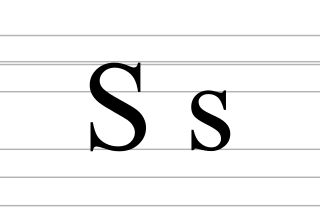
S, or s, is the nineteenth letter of the Latin alphabet, used in the modern English alphabet, the alphabets of other western European languages and others worldwide. Its name in English is ess, plural esses.

Y, or y, is the twenty-fifth and penultimate letter of the Latin alphabet, used in the modern English alphabet, the alphabets of other western European languages and others worldwide. According to some authorities, it is the sixth vowel letter of the English alphabet. Its name in English is wye, plural wyes.

The letter yogh (ȝogh) was used in Middle English and Older Scots, representing y and various velar phonemes. It was derived from the Insular form of the letter g, Ᵹᵹ.

Z, or z, is the twenty-sixth and last letter of the Latin alphabet. It is used in the modern English alphabet, in the alphabets of other Western European languages, and in others worldwide. Its usual names in English are zed, which is most commonly used in International English and zee, only used in American, sometimes Canadian and Caribbean English and with an occasional archaic variant izzard.
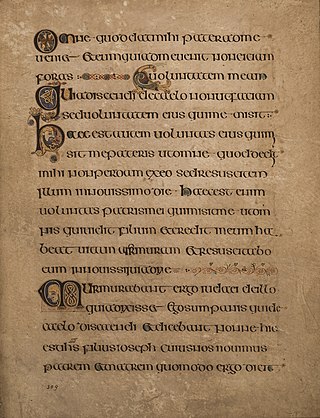
Uncial is a majuscule script commonly used from the 4th to 8th centuries AD by Latin and Greek scribes. Uncial letters were used to write Greek and Latin, as well as Gothic, and are the current style for Coptic and Nobiin.
Finnish orthography is based on the Latin script, and uses an alphabet derived from the Swedish alphabet, officially comprising twenty-nine letters but also including two additional letters found in some loanwords. The Finnish orthography strives to represent all morphemes phonologically and, roughly speaking, the sound value of each letter tends to correspond with its value in the International Phonetic Alphabet (IPA) – although some discrepancies do exist.

Carolingian minuscule or Caroline minuscule is a script which developed as a calligraphic standard in the medieval European period so that the Latin alphabet of Jerome's Vulgate Bible could be easily recognized by the literate class from one region to another. It is thought to have originated before 778 CE at the scriptorium of the Benedictine monks of Corbie Abbey, about 150 kilometres north of Paris, and then developed by Alcuin of York for wide use in the Carolingian Renaissance. Alcuin himself still wrote in a script which was a precursor to the Carolingian minuscule, which slowly developed over three centuries. He was most likely responsible for copying and preserving the manuscripts and upkeep of the script. It was used in the Holy Roman Empire between approximately 800 and 1200. Codices, pagan and Christian texts, and educational material were written in Carolingian minuscule.
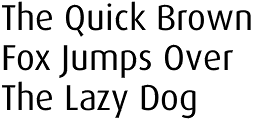
Modern English is written with a Latin-script alphabet consisting of 26 letters, with each having both uppercase and lowercase forms. The word alphabet is a compound of alpha and beta, the names of the first two letters in the Greek alphabet. Old English was first written down using the Latin alphabet during the 7th century. During the centuries that followed, various letters entered or fell out of use. By the 16th century, the present set of 26 letters had largely stabilised:

EzhEZH, also called the "tailed z", is a letter, notable for its use in the International Phonetic Alphabet (IPA) to represent the voiced postalveolar fricative consonant. For example, the pronunciation of "si" in vision and precision, or the ⟨s⟩ in treasure. See also the letter ⟨Ž⟩ as used in many Slavic languages, the Persian alphabet letter ⟨ژ⟩, the Cyrillic letter ⟨Ж⟩, the Devanagari letter (झ़) and the Esperanto letter ⟨Ĵ⟩.

Insular G is a form of the letter g somewhat resembling an ezh, used in the medieval insular script of Great Britain and Ireland. It was first used in the Roman Empire in Roman cursive, then it appeared in Irish half uncial (insular) script, and after it had passed into Old English, it developed into the Middle English letter yogh. Middle English, having reborrowed the familiar Carolingian g from the Continent, began to use the two forms of g as separate letters.

J, or j, is the tenth letter of the Latin alphabet, used in the modern English alphabet, the alphabets of other western European languages and others worldwide. Its usual name in English is jay, with a now-uncommon variant jy.
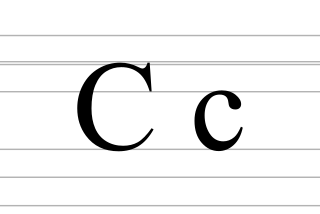
C, or c, is the third letter of the Latin alphabet, used in the modern English alphabet, the alphabets of other western European languages and others worldwide. Its name in English is cee, plural cees.

The Latin script, also known as the Roman script, is a writing system based on the letters of the classical Latin alphabet, derived from a form of the Greek alphabet which was in use in the ancient Greek city of Cumae in Magna Graecia. The Greek alphabet was altered by the Etruscans, and subsequently their alphabet was altered by the Ancient Romans. Several Latin-script alphabets exist, which differ in graphemes, collation and phonetic values from the classical Latin alphabet.

The Latin script is the most widely used alphabetic writing system in the world. It is the standard script of the English language and is often referred to simply as "the alphabet" in English. It is a true alphabet which originated in the 7th century BC in Italy and has changed continually over the last 2,500 years. It has roots in the Semitic alphabet and its offshoot alphabets, the Phoenician, Greek, and Etruscan. The phonetic values of some letters changed, some letters were lost and gained, and several writing styles ("hands") developed. Two such styles, the minuscule and majuscule hands, were combined into one script with alternate forms for the lower and upper case letters. Modern uppercase letters differ only slightly from their classical counterparts, and there are few regional variants.

B, or b, is the second letter of the Latin alphabet, used in the modern English alphabet, the alphabets of other western European languages and others worldwide. Its name in English is bee, plural bees.






















